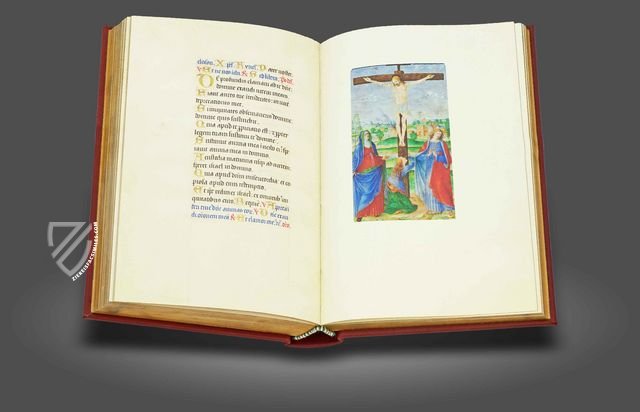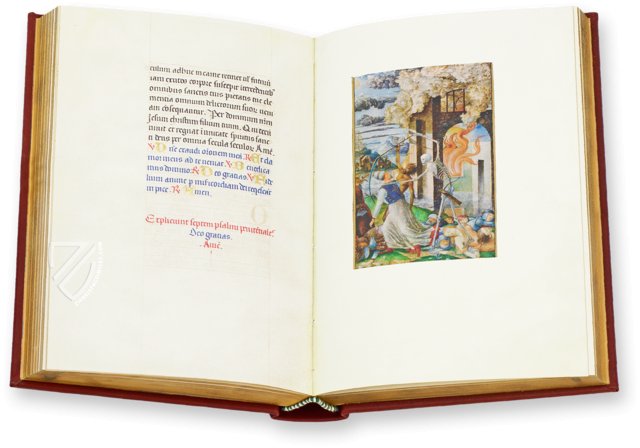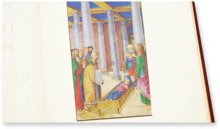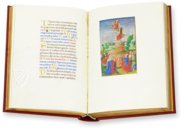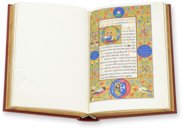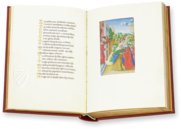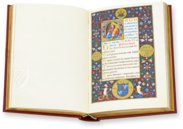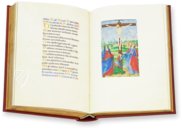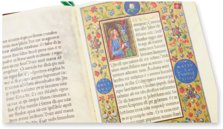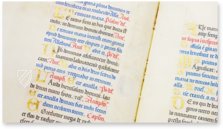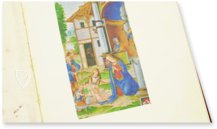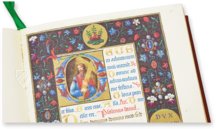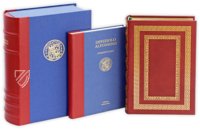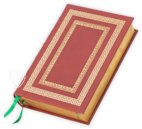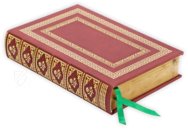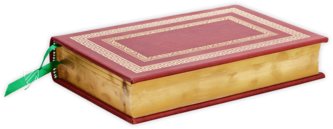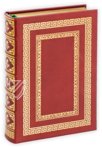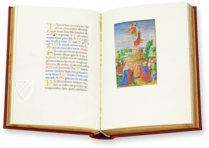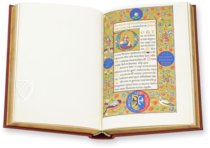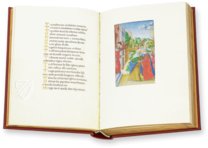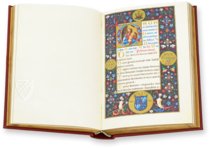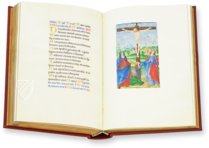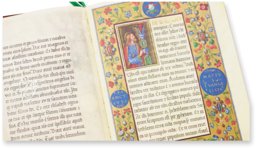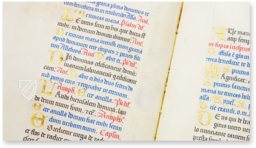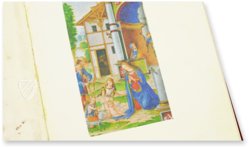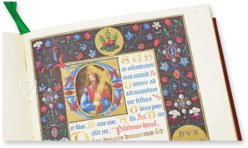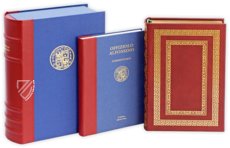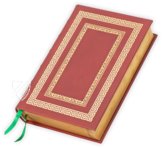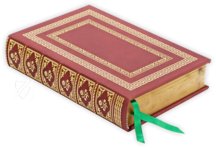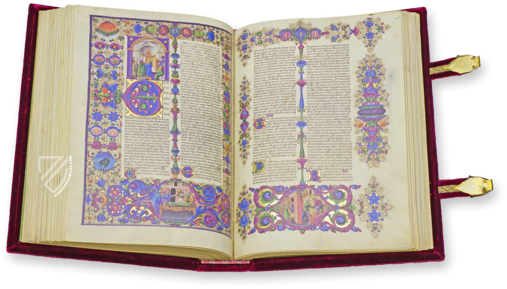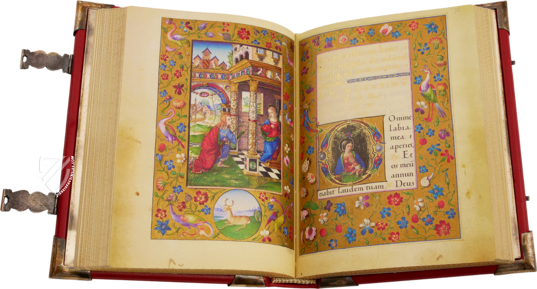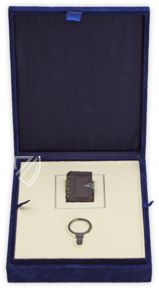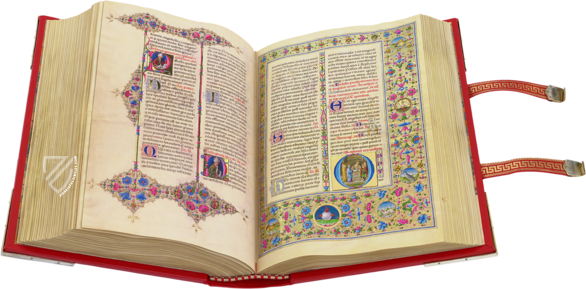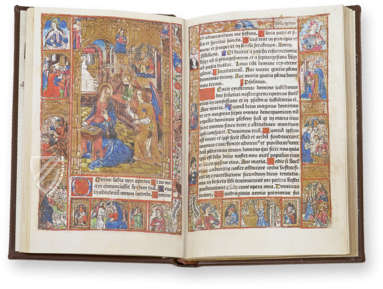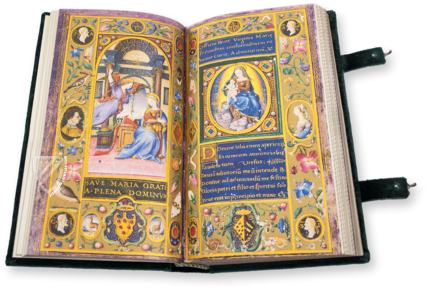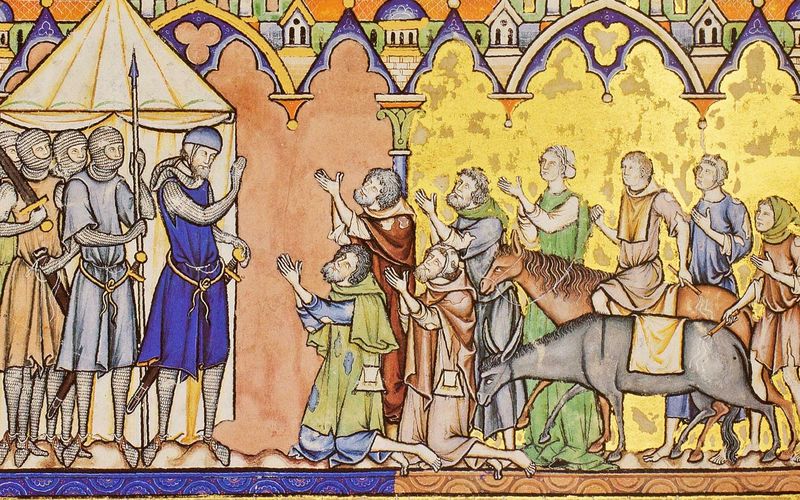Offiziolo Alfonsino
(3,000€ - 7,000€)
The Book of Hours of Alfonso d’Este was made between 1505 and 1510 by the Italian master Matteo da Milano at the Duke’s court in Ferrara. Today, it is considered to be the last great masterpiece of book art from Ferrera. The magnificent work is especially captivating because of its 29 splendidly designed full-page miniatures and its fascinating bordures. The pictorial adornment of the work shimmers in luminous colors and precious gold leaf.
Offiziolo Alfonsino
In the year 1505, Alfonso I d’Este, Duke of Ferrara, Regio, and Modena, commissioned an illuminated manuscript that is considered today to be the last truly exceptional creation by the book artists of Ferrara. The Offiziolo Alfonsino is one of the greatest masterpieces among the manuscripts of the Middle Ages and is unbelievably richly decorated. The work comprises 199 pages, the first 12 pages of which exhibit an elaborately decorated calendar. 29 pages are completely illustrated, 10 pages exhibit small miniatures and all of the texts are embellished with golden initials.
Coveted Book Art of the Renaissance
Duke Alfonso I d’Este reigned from June 15, 1505 to October 31, 1534 and proved himself to be a significant statesman and general during a period of political instability. He was equally considered to be one of the greatest patrons of the Renaissance. The greatest Renaissance artists were employed at his court. Among others, he commissioned a picture cycle from Titian, wherefore he constructed a gallery in his study. Along with the Bible of Borso d’Este and the Breviary of Ercole d’Este, his book of hours forms a trilogy of the finest illumination art and was one of the most beautiful books in the Library of Modena until 1859. At a time still unknown, 14 full-page miniature were removed from the splendid work and arose in the library of the Croatian Bishop Strossmayer ca. 1884. These pages are found today in the holdings of the Strossmayer Gallery in Zagreb. The main part of the valuable manuscript is found today in the Calouste Gulbenkian Museum in Lisbon.
Masterful Book Adornment
The Italian illuminator Matteo da Milano is responsible for the dreamlike illustrations of the book of hours. The unbelievably talented painter already designed the Breviary of Ercole d’Este as well as the Book of Hours of Bonaparte Ghislieri. His characteristic style distinguishes itself through exciting, innovative bordure painting and through the combination of various stylistic influences. In his art, he allowed himself to be equally inspired by classical painting from antiquity as well as Flemish and northern European characteristics. In the Book of Hours of Alfonso d’Este, the master presents his abilities in a breathtaking manner. The prayers of the religious book are initiated by historiated initials and lavishly decorated frames. The backgrounds, shimmering in gold or black with a gold pattern, are embellished with pearls, costly gemstones, flowers, fruits, and beasts. A few pages exhibit fantastical and grotesque creatures.
Codicology
- Alternative Titles
- Book of Hours of Alfonso d'Este
Hours of Alfonso d'Este
Stundenbuch des Alfonso d'Este
Libro d'ore di Alfonso I d'Este - Size / Format
- 398 pages / 26.0 × 17.0 cm
- Origin
- Italy
- Date
- 1505–1510
- Epochs
- Style
- Genre
- Language
- Script
- Gothic Textura
- Illustrations
- 29 full-page miniatures, numerous decorated borders, coat of arms, and initials
- Patron
- Duke Alfonso I d'Este (1476–1534)
- Artist / School
- Matteo da Milano (fl. 1492–1523)
- Previous Owners
- Estense Modena Library
House of Austria-Este in Vienna
Offiziolo Alfonsino
Kiss of Judas
This famous scene from the Garden of Gethsemane is one of the most popular in medieval Christian art. Here, Judas gives the prearranged signal to the mob as one of the Twelve Apostles wrestles on the ground with a member of the mob. This scene mixes classical forms, such as the robes worn by Jesus and his disciples, with contemporary clothing and armor worn by the soldiers who have come to arrest Jesus. The armor of the early-16th century is portrayed with a surprising degree of detail.
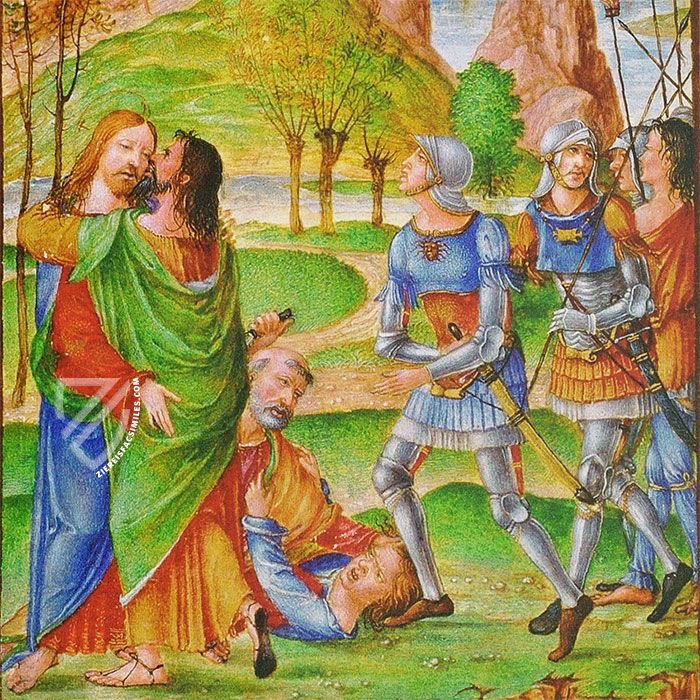
Offiziolo Alfonsino
Incipit Page with Coat of Arms
Text in red, blue, and golden ink introduces this gorgeous page along with an “I” initial consisting of a column that Christ is reading in front of while dressed in colorful robes. These prayers from the Gospel of Luke are presented in a wonderful black frame that emphasizes the rich, bright colors of the flowers, gemstones, drolleries, and golden medallions.
Alfonso d’Este’s coat of arms at the bottom of the page is flanked by these two drolleries. On the left, the creature has the body of a bird with the tail of a snake and three dragon heads. The creature on the right also has the head of a dragon and a bizarre body with the hind legs of a dog, front legs like an insect, and the breasts of a human woman.
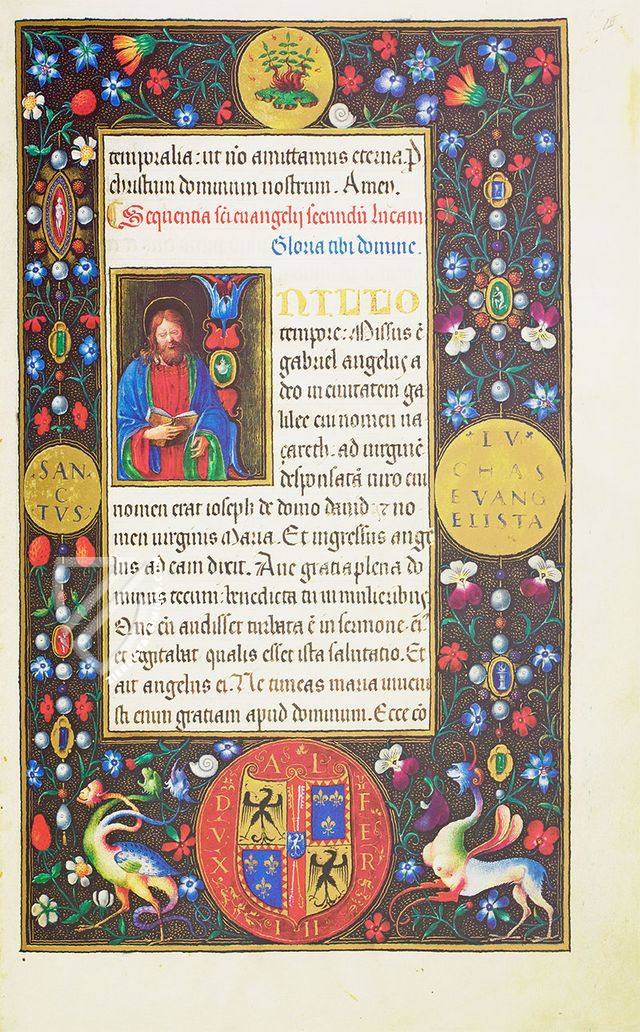
#1 Offiziolo Alfonsino
Languages: Italian, German, English
(3,000€ - 7,000€)
- Treatises / Secular Books
- Apocalypses / Beatus
- Astronomy / Astrology
- Bestiaries
- Bibles / Gospels
- Chronicles / History / Law
- Geography / Maps
- Saints' Lives
- Islam / Oriental
- Judaism / Hebrew
- Single Leaf Collections
- Leonardo da Vinci
- Literature / Poetry
- Liturgical Manuscripts
- Medicine / Botany / Alchemy
- Music
- Mythology / Prophecies
- Psalters
- Other Religious Books
- Games / Hunting
- Private Devotion Books
- Other Genres
- Afghanistan
- Armenia
- Austria
- Belgium
- Belize
- Bosnia and Herzegovina
- China
- Colombia
- Costa Rica
- Croatia
- Cyprus
- Czech Republic
- Denmark
- Egypt
- El Salvador
- Ethiopia
- France
- Germany
- Greece
- Guatemala
- Honduras
- Hungary
- India
- Iran
- Iraq
- Israel
- Italy
- Japan
- Jordan
- Kazakhstan
- Kyrgyzstan
- Lebanon
- Liechtenstein
- Luxembourg
- Mexico
- Morocco
- Netherlands
- Palestine
- Panama
- Peru
- Poland
- Portugal
- Romania
- Russia
- Serbia
- Spain
- Sri Lanka
- Sweden
- Switzerland
- Syria
- Tajikistan
- Turkey
- Turkmenistan
- Ukraine
- United Kingdom
- United States
- Uzbekistan
- Vatican City
- A. Oosthoek, van Holkema & Warendorf
- Aboca Museum
- Ajuntament de Valencia
- Akademie Verlag
- Akademische Druck- u. Verlagsanstalt (ADEVA)
- Aldo Ausilio Editore - Bottega d’Erasmo
- Alecto Historical Editions
- Alkuin Verlag
- Almqvist & Wiksell
- Amilcare Pizzi
- Andreas & Andreas Verlagsbuchhandlung
- Archa 90
- Archiv Verlag
- Archivi Edizioni
- Arnold Verlag
- ARS
- Ars Magna
- ArtCodex
- AyN Ediciones
- Azimuth Editions
- Badenia Verlag
- Bärenreiter-Verlag
- Belser Verlag
- Belser Verlag / WK Wertkontor
- Benziger Verlag
- Bernardinum Wydawnictwo
- BiblioGemma
- Biblioteca Apostolica Vaticana (Vaticanstadt, Vaticanstadt)
- Bibliotheca Palatina Faksimile Verlag
- Bibliotheca Rara
- Boydell & Brewer
- Bramante Edizioni
- Bredius Genootschap
- Brepols Publishers
- British Library
- C. Weckesser
- Caixa Catalunya
- Canesi
- CAPSA, Ars Scriptoria
- Caratzas Brothers, Publishers
- Carus Verlag
- Casamassima Libri
- Centrum Cartographie Verlag GmbH
- Chavane Verlag
- Christian Brandstätter Verlag
- Circulo Cientifico
- Club Bibliófilo Versol
- Club du Livre
- CM Editores
- Collegium Graphicum
- Collezione Apocrifa Da Vinci
- Comissão Nacional para as Comemorações dos Descobrimentos Portugueses
- Coron Verlag
- Corvina
- CTHS
- D. S. Brewer
- Damon
- De Agostini/UTET
- De Nederlandsche Boekhandel
- De Schutter
- Deuschle & Stemmle
- Deutscher Verlag für Kunstwissenschaft
- DIAMM
- Droz
- E. Schreiber Graphische Kunstanstalten
- Ediciones Boreal
- Ediciones Grial
- Ediclube
- Edições Inapa
- Edilan
- Editalia
- Edition Deuschle
- Edition Georg Popp
- Edition Leipzig
- Edition Libri Illustri
- Editiones Reales Sitios S. L.
- Éditions de l'Oiseau Lyre
- Editions Medicina Rara
- Editorial Casariego
- Editorial Mintzoa
- Editrice Antenore
- Editrice Velar
- Edizioni Edison
- Egeria, S.L.
- Eikon Editores
- Electa
- Emery Walker Limited
- Enciclopèdia Catalana
- Eos-Verlag
- Ephesus Publishing
- Ernst Battenberg
- Eugrammia Press
- Extraordinary Editions
- Fackelverlag
- Facsimila Art & Edition
- Facsimile Editions Ltd.
- Facsimilia Art & Edition Ebert KG
- Faksimile Verlag
- Feuermann Verlag
- Folger Shakespeare Library
- Franco Cosimo Panini Editore
- Friedrich Wittig Verlag
- Fundación Hullera Vasco-Leonesa
- G. Braziller
- Gabriele Mazzotta Editore
- Gebr. Mann Verlag
- Gesellschaft für graphische Industrie
- Getty Research Institute
- Giovanni Domenico de Rossi
- Giunti Editore
- Graffiti
- Grafica European Center of Fine Arts
- Guido Pressler
- Guillermo Blazquez
- Gustav Kiepenheuer
- H. N. Abrams
- Harrassowitz
- Harvard University Press
- Helikon
- Hendrickson Publishers
- Henning Oppermann
- Herder Verlag
- Hes & De Graaf Publishers
- Hoepli
- Holbein-Verlag
- Houghton Library
- Hugo Schmidt Verlag
- Idion Verlag
- Il Bulino, edizioni d'arte
- ILte
- Imago
- Insel Verlag
- Insel-Verlag Anton Kippenberger
- Instituto de Estudios Altoaragoneses
- Instituto Nacional de Antropología e Historia
- Introligatornia Budnik Jerzy
- Istituto dell'Enciclopedia Italiana - Treccani
- Istituto Ellenico di Studi Bizantini e Postbizantini
- Istituto Geografico De Agostini
- Istituto Poligrafico e Zecca dello Stato
- Italarte Art Establishments
- Jan Thorbecke Verlag
- Johnson Reprint Corporation
- Josef Stocker
- Josef Stocker-Schmid
- Jugoslavija
- Karl W. Hiersemann
- Kasper Straube
- Kaydeda Ediciones
- Kindler Verlag / Coron Verlag
- Kodansha International Ltd.
- Konrad Kölbl Verlag
- Kurt Wolff Verlag
- La Liberia dello Stato
- La Linea Editrice
- La Meta Editore
- Lambert Schneider
- Landeskreditbank Baden-Württemberg
- Leo S. Olschki
- Les Incunables
- Liber Artis
- Library of Congress
- Libreria Musicale Italiana
- Lichtdruck
- Lito Immagine Editore
- Lumen Artis
- Lund Humphries
- M. Moleiro Editor
- Maison des Sciences de l'homme et de la société de Poitiers
- Manuscriptum
- Martinus Nijhoff
- Maruzen-Yushodo Co. Ltd.
- MASA
- Massada Publishers
- McGraw-Hill
- Metropolitan Museum of Art
- Militos
- Millennium Liber
- Müller & Schindler
- Nahar - Stavit
- Nahar and Steimatzky
- National Library of Wales
- Neri Pozza
- Nova Charta
- Oceanum Verlag
- Odeon
- Orbis Mediaevalis
- Orbis Pictus
- Österreichische Staatsdruckerei
- Oxford University Press
- Pageant Books
- Parzellers Buchverlag
- Patrimonio Ediciones
- Pattloch Verlag
- PIAF
- Pieper Verlag
- Plon-Nourrit et cie
- Poligrafiche Bolis
- Presses Universitaires de Strasbourg
- Prestel Verlag
- Princeton University Press
- Prisma Verlag
- Priuli & Verlucca, editori
- Pro Sport Verlag
- Propyläen Verlag
- Pytheas Books
- Quaternio Verlag Luzern
- Reales Sitios
- Recht-Verlag
- Reichert Verlag
- Reichsdruckerei
- Reprint Verlag
- Riehn & Reusch
- Roberto Vattori Editore
- Rosenkilde and Bagger
- Roxburghe Club
- Salerno Editrice
- Saltellus Press
- Sandoz
- Sarajevo Svjetlost
- Schöck ArtPrint Kft.
- Schulsinger Brothers
- Scolar Press
- Scrinium
- Scripta Maneant
- Scriptorium
- Shazar
- Siloé, arte y bibliofilia
- SISMEL - Edizioni del Galluzzo
- Sociedad Mexicana de Antropología
- Société des Bibliophiles & Iconophiles de Belgique
- Soncin Publishing
- Sorli Ediciones
- Stainer and Bell
- Studer
- Styria Verlag
- Sumptibus Pragopress
- Szegedi Tudomànyegyetem
- Taberna Libraria
- Tarshish Books
- Taschen
- Tempus Libri
- Testimonio Compañía Editorial
- Thames and Hudson
- The Clear Vue Publishing Partnership Limited
- The Facsimile Codex
- The Folio Society
- The Marquess of Normanby
- The Richard III and Yorkist History Trust
- Tip.Le.Co
- TouchArt
- TREC Publishing House
- TRI Publishing Co.
- Trident Editore
- Tuliba Collection
- Typis Regiae Officinae Polygraphicae
- Union Verlag Berlin
- Universidad de Granada
- University of California Press
- University of Chicago Press
- Urs Graf
- Vallecchi
- Van Wijnen
- VCH, Acta Humaniora
- VDI Verlag
- VEB Deutscher Verlag für Musik
- Verlag Anton Pustet / Andreas Verlag
- Verlag Bibliophile Drucke Josef Stocker
- Verlag der Münchner Drucke
- Verlag für Regionalgeschichte
- Verlag Styria
- Vicent Garcia Editores
- W. Turnowski Ltd.
- W. Turnowsky
- Waanders Printers
- Wiener Mechitharisten-Congregation (Wien, Österreich)
- Wissenschaftliche Buchgesellschaft
- Wissenschaftliche Verlagsgesellschaft
- Wydawnictwo Dolnoslaskie
- Xuntanza Editorial
- Zakład Narodowy
- Zollikofer AG

